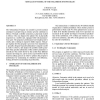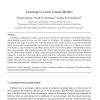396 search results - page 35 / 80 » How scientific models can explain |
IJCAI
2001
13 years 9 months ago
2001
Supervised and unsupervised learning methods have traditionally focused on data consisting of independent instances of a single type. However, many real-world domains are best des...
TJS
2008
13 years 7 months ago
2008
Multiple memory models have been proposed to capture the effects of memory hierarchy culminating in the I-O model of Aggarwal and Vitter [?]. More than a decade of architectural a...
WSC
2004
13 years 9 months ago
2004
The Telemedicine Program was created to provide medical assistance to people living in extreme poverty conditions in Mexico. Through a satellite connection, a physician located in...
COGSCI
2010
13 years 7 months ago
2010
Learning to understand a single causal system can be an achievement, but humans must learn about multiple causal systems over the course of a lifetime. We present a hierarchical B...
ATAL
2007
Springer
14 years 1 months ago
2007
Springer
We present a simple ant model that solves a discrete foraging problem. We describe simulations and provide a complete convergence analysis: we show that the ant population compute...


